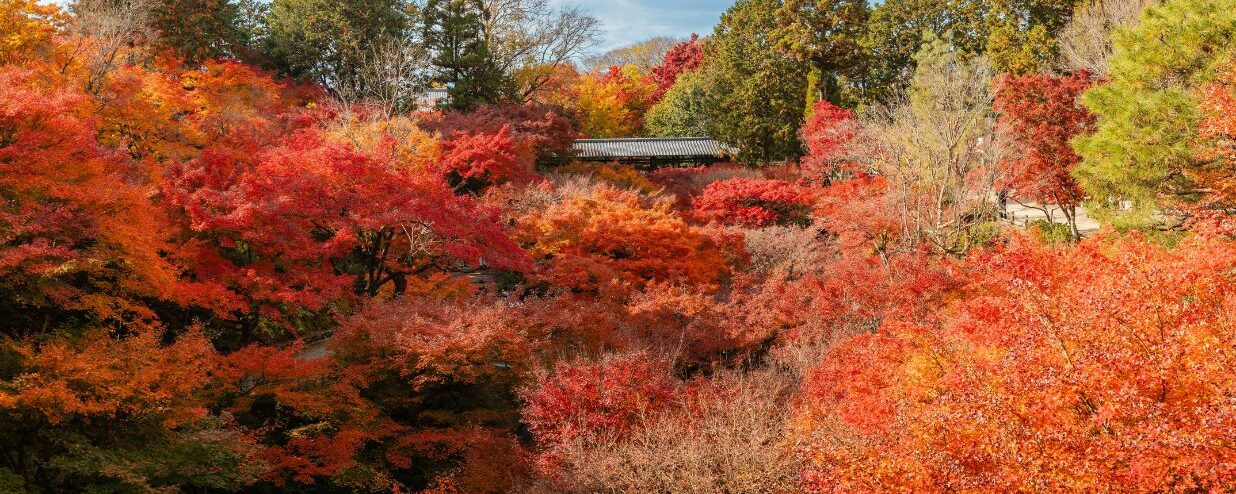When is the best time to enjoy momiji (autumn leaves) in Japan, and what are the best viewing locations? While Japan is revered for its cherry blossoms in the spring, autumn foliage is an equally beautiful sight, but, sadly, not as well known. Momijigari (紅葉狩り), which means “red leaf hunting” or “maple leaf hunting”, is a custom of admiring the changing colors of leaves to vibrant red, brown, yellow, and orange during fall in Japan. It has been practiced for centuries by the Japanese, drawing inspiration for artists and poets.
Like hanami (cherry blossom viewing), admiring the gradient autumn leaves is done when the temperature cools down. Fall is one of the best times to experience Japan, as the chill weather and clear skies make it especially nice for you to take a stroll and enjoy the outdoor view.
We’ll give you a thorough guide to help you plan the perfect momijigari experience.
Autumn in Japanese: Aki, Momiji, and Kouyou
Autumn in Japan is aki (秋). Most people familiar with Japanese culture have probably heard the more common fall-related term: momiji (紅葉). However, fall foliage is classified into two categories: the former and another called kouyou.
Surprisingly, kouyou and momiji have the same kanji, 紅葉. The characters translate to “red leaves.” Both are strongly tied to the activity of experiencing a fall in Japan. Historically, the characters are read as momiji (もみじ), which means “red leaves” and “maple tree.”
Notice that the changing autumn leaves aren’t just shades of brown and red. Kouyou describes foliage with red and yellow colors, while Momiji particularly describes the intense red color of maple leaves.
The custom of visiting scenic areas where leaves have turned red is called 紅葉狩, or もみじがり (momijigari). This tradition was born during the Heian Era in the Kyoto region’s aristocracy. In this era, the word 狩 (かり), or kari, means hunting and was used to speak not only about hunting deer but also about picking fruit.
Of course, the Japanese nobility did not participate in such activities but greatly admired nature’s beauty. Finally, the aristocracy borrowed the word 狩 (かり) and started to use 紅葉狩 (もみじがり) to mean “red leaves viewing,” especially around Kyoto’s temples. Trees were planted specifically for this refined autumn hobby of the era’s elite.
Now, momijigari is a unique tradition that allows Japanese people to admire the season before winter comes.
When to Enjoy Fall Leaves in Japan
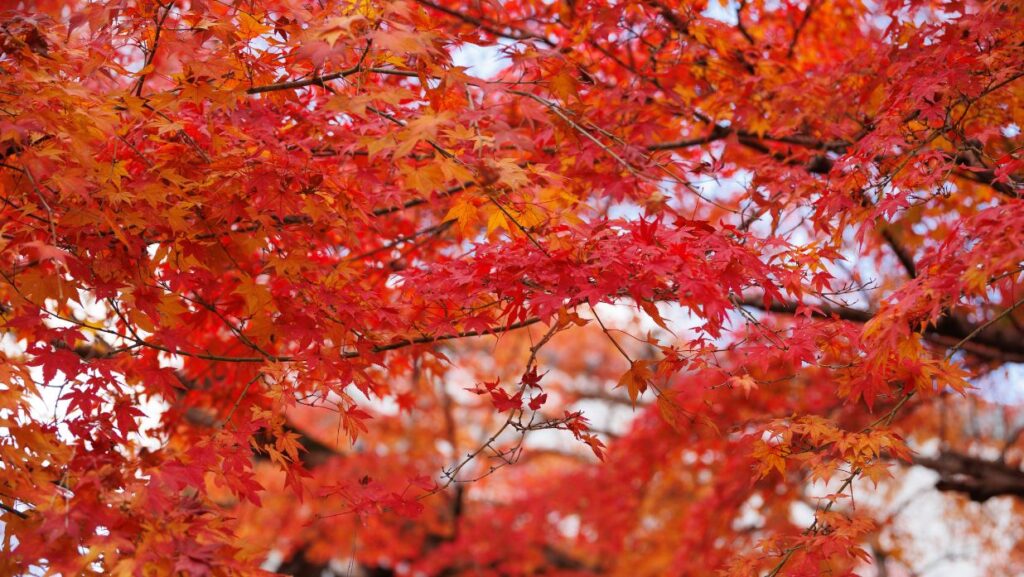
Generally, autumn in Japan starts in September, although this varies from prefecture to prefecture because of regional climate, latitude, and elevation. For example, while most regions peak in November, colder areas can start changing their leaf colors earlier, while others go as late as December. This should give you ample time to enjoy this seasonal spectacle. You can catch the leaves anytime from the end of September to December.
The autumn foliage season starts in mid-September in Hokkaido, Japan’s northernmost region. From the north, the change of fall colors moves southward by mid-October. The progression of fall leaves is called koyo zensen (紅葉前線).
Places like Kyoto and Tokyo have peak viewing that lasts two weeks to one month, typically from mid-October to early December. That said, the end of November is probably the peak time to experience Momiji and Koyo in Japan.
Autumn Foliage Forecast Japan
| City | Estimated color peak |
| Hokkaido | mid-September to early November |
| Tohoku | early October to mid-November |
| Nikko | mid-September to late October |
| Hakone | early November to late November |
| Tokyo | mid-November to early December |
| Fuji | late October to mid-November |
| Kanazawa | mid-November to early December |
| Kansai (Kyoto, Nara, Osaka) | mid-November to early December |
All the popular spots (Nikko, Oirase, and Kyoto) release their forecasts. As for the best time to see Momiji, it is usually around one month after the leaves turn red in Hokkaido for the Tohoku region (around October), and early November to December in the Kyushu and Kanto regions.
Check out the most up-to-date autumn foliage forecast in Japan here.
Want to study Japanese with us?
Japan is already a beautiful place on its own, so any region is great for koyo and momiji viewing in the autumn. Even if you are in a modern city like Tokyo or Osaka, city parks and streets are lined with hundreds (if not thousands) of trees for koyo and momijigari. Besides, Japan offers mountainous hiking trails, an excellent alternative for outdoor lovers wishing to experience the Japanese countryside.
Still, a few places are worth visiting for autumn leaf spots in Japan.
Where to Enjoy Autumn Foliage in Tokyo
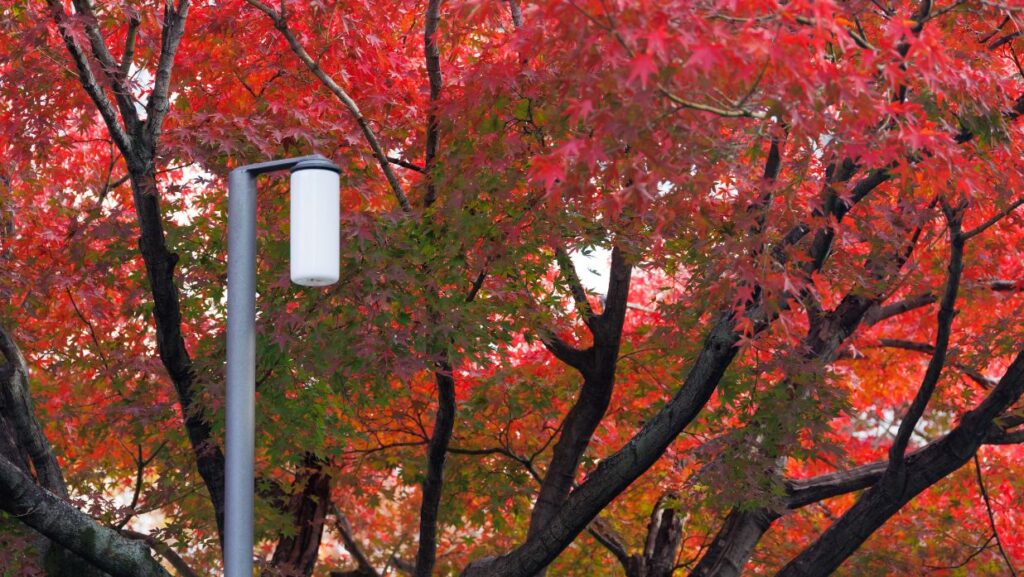
Although not as nature-heavy as its neighboring regions, Tokyo is still packed with green spaces that make it ideal for momijigari. The ginkgo tree, known as icho in Japanese, is the official tree of Tokyo. It lines many of the city’s streets and turns a bright yellow during autumn. Some of the most popular include:
1. Mount Takao
Mount Takao is the closest natural recreation area to central Tokyo, making it the perfect hiking and outdoor spot. Autumn in Mount Takao is especially spectacular, as the entire mountain is covered in red and yellow leaves. The best way to enjoy the scenery is by riding the cable car from Kiyoaki Station and Takaosan Station. You’ll ascend the 599-meter summit, which gives you a more relaxed experience of seeing the stunning autumn leaves.
2. Yoyogi Park
Yoyogi Park is located near Harajuku. It is famed for its ginkgo trees, which turn luminous gold-yellow in fall, and its maple trees. You’ll see a beautiful contrast of yellow and stark red, spectacular autumn color combos. The best time to see Momiji in Yoyogi Park is from the end of November to mid-December.
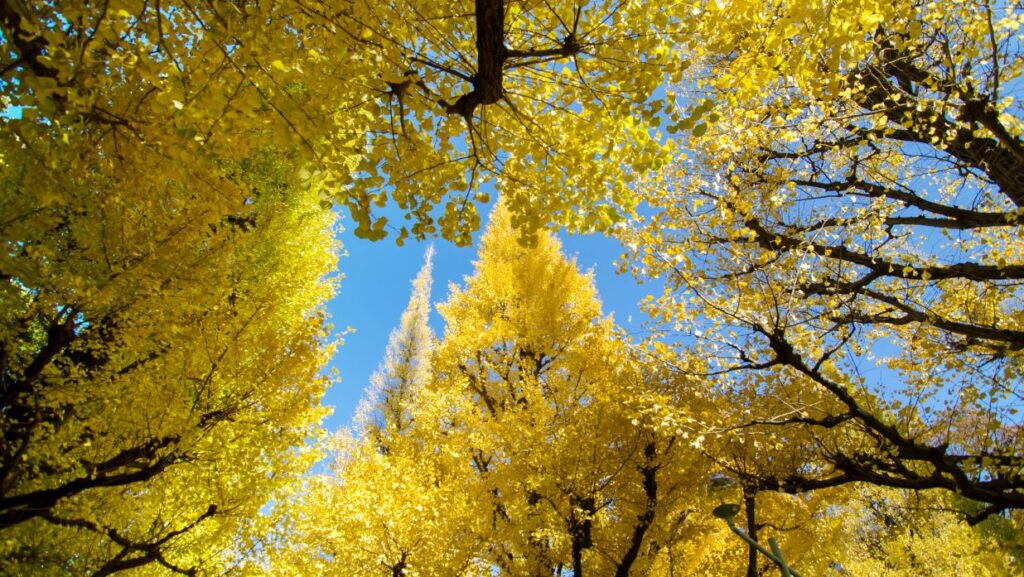
3. Showa Kinen Park
Tokyo’s iconic fall foliage spot is the 300-meter trail lined with ginkgo trees. The trail is lined with one hundred trees over 20 meters high. The best time to view them is during mid-November, and it’s relatively accessible. The closest station is Tachikawa Station, a 20-minute train ride from Shinjuku. You can also rent a bike to go around the park and admire the stunning golden trees.
4. Shinjuku Gyoen National Park
The Shinjuku Gyoen National Park is one of Tokyo’s largest parks, with three gardens combined into one giant area. Around the park, different types of trees change to shades of red, orange, yellow, and brown, creating a vibrant gradient effect.
The maple trees in the Japanese Garden are particularly beautiful, although you can also see these maple trees on the park’s eastern side. The British Garden has more ginkgo leaves. The colors typically appear from mid-November to mid-December.
5. Meiji Jingu Gaien
The 300-meter-long Ginkgo Avenue is one of Tokyo’s most popular Momiji viewing spots. The road stretches from the Aoyama Nichome intersection to the outer gardens of Meiji Shrine. The wide road has 14 conical trees that turn bright yellow in late November, which makes it as if you’re walking in a golden tunnel.
The ginkgo tree, known as icho in Japanese, is the official tree of Tokyo, and it lines many of the city’s streets. The most famous of these is the Ginkgo Avenue in Meiji-Jingu Gaien Park. These stately conical trees turn bright yellow in late November.
6. Mizumoto Park
Mizumoto Park is the biggest riverside park in Tokyo, also famous for its 1,800 dawn redwood trees. Most of them are more than 20 meters in height, creating beautiful autumn foliage. During fall, its highlight is the around 1,800 dawn redwood trees, also called Metasequoia, and their beautiful foliage.
Best Spots to Go Hunting in Kyoto
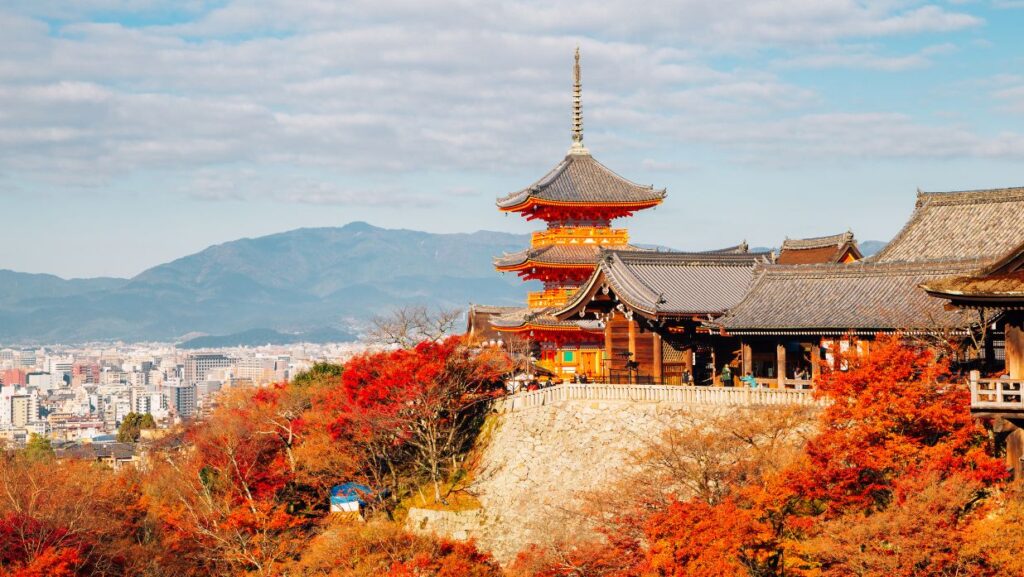
A popular destination for autumn leaves in Japan is Kyoto, renowned for its traditional temples and forests. It’s considered the best city in Japan to experience autumn. During autumn, the leaves change colors all over Kyoto, and visitors flock to popular tourist destinations.
1. Ruriko-in Temple, Kyoto
A heavily protected cultural property, Ruriko-in Temple in Kyoto, cannot normally be visited during the majority of the year. If you’re lucky, you might be able to enter this sacred place during the brief window when it’s open to the public, just twice a year: once in spring and once in autumn.
It used to be a lesser-known spot out of areas famous for autumn leaves viewing in Kyoto until it gained popularity through social media. The picturesque shot is iconic: against the black lacquered floor, people will take a photo of the brilliant red Momiji (Japanese maple) surrounding the area. The floors also mirror the fall foliage, accentuating the autumn atmosphere at the temple and creating a stunning visual effect.
2. Tofukoji Temple
The Tsutenkyo Bridge, located on the temple grounds, is Tokyo’s most popular autumn viewing location. It is a place where you can see the orange and red autumn leaves.
The Tofukuji Temple is one of the most popular koyo locations in Kyoto. Its trees blaze with an orange and red coloration. The Tsutenkyo Bridge offers an impressive view of the temple grounds.
3. Arashiyama
The bamboo forest is located on the outskirts of Kyoto. Arashiyama offers a magnificent view of brown, yellow, and red leaves from the forested mountains, which consist of multicolored trees. You can also enjoy the momiji on the Sagano Scenic train. Head there between late November and December.
4. Eikando Temple
While most momijigari spots in Japan are best visited during the day, the grounds of Eikando Temple are illuminated at night to enable nighttime viewing.
Other Beautiful Places to Admire Autumn Leaves in Japan
If you get the chance to travel all over Japan in the autumn, you’ll not be short of finding beautiful, painting-like sceneries of the fall. Thankfully, there’s a lot of time to enjoy the seasonal spectacle.
1. Mount Fuji (Fuji Five Lakes), Yamanashi

Japan’s highest mountain is also a popular spot during the autumn season. The trees surrounding the Fuji Five Lakes (Yamanakako, Kawaguchiko, Saiko, Shojiko, and Motosuko)turn to amber and golden shades; the most popular of these lakes is Lake Kawaguchi. We recommend renting a boat to tour the lake, as you’ll get the scenery of Mount Fuji and tree reflections. The “Momiji Corridor” captures both Mount Fuji and fall foliage simultaneously, so you’ll see tourists lining up and gathering for the perfect shot.
2. Nikko, Tochigi
A popular day trip from Tokyo, Nikko’s picturesque nature and UNESCO World Heritage temples make the autumn there especially magical. Nikko’s peak season for autumn leaves usually runs from early October to early November.
The Shinkyo Bridge, early recognizable from its iconic red color against the backdrop of mountainous forests, sits near the entrance to Nikko’s shrines and temples and is surrounded by colorful autumn foliage.
Ryuzu Falls is another spot in Nikko where you can experience autumn. The waterfall is flanked by trees that turn yellow and red in early October, giving it a dragon-like appearance. The waterfall can be viewed free of charge from a small observation deck in the back of a rest house.
3. Jozankei, Hokkaido
Already a famous spot as the onsen (hot spring) town in Hokkaido, another way to admire Jozankei and autumn in Japan simultaneously is by riding a canoe on the river, surrounded by mountains, and the vividly colored autumn leaves can be enjoyed on all sides.
From mid-October, the foliage at the foot of Mt. Hakkenzan gradually turns red and yellow, and the sight can be seen from the nearby national highway. Visitors can enjoy Western-style horse riding at the foot of the mountain at the Wild Mustang’s horse-riding facility.
The eight-seater cable car, Koyo Gondola, also operates from late September to mid-October. It brings you to an observation deck at the summit station, which offers views of the autumn leaves, Ishikari Bay, and Otaru Port.
4. Minoo Park, Osaka
Arguably the best place for autumn colors in Osaka, Minoo Park is strategically located in the suburbs, a short train ride from the city. Minoo Park is most known for its colorful fall foliage, which you can view as you go on the hiking trail. The trail begins near Hankyu Minoo Station and leads to the Minoo Waterfall, its iconic attraction.
During the fall season, the shops alongside the path sell an interesting snack inspired by autumn: momiji tempura, which consists of maple leaves deep-fried in batter.
5. Nara Park, Nara
Already famous for its friendly sika deer, Nara Park is a spacious park and is said to be one of the oldest public parks in Japan. It is in the center of Nara city, at the foot of Mount Wakakusa. Generally, the best time to see the leaves change during autumn in Nara is between October and late November. Head to Todaiji Temple, surrounded by red Momiji maple trees, evergreen trees, ginkgo, and deer.
Conclusion: Enjoy Japan’s Autumn, Travel Like a Local, and Learn Japanese
Japan is a beautiful country to visit any time of year, and what better way to experience it fully than by learning a bit of Japanese to immerse yourself in the culture?
If you want to build confidence and start speaking Japanese, consider joining conversation-focused Japanese lessons at Coto Academy. As a top-rated school with campuses in Tokyo and Yokohama, we offer fun and flexible lessons designed around practical, everyday conversation. You’ll learn Japanese that you can use immediately outside the classroom.
We offer intensive Japanese courses as well as part-time options, so whether you want to immerse yourself fully or fit lessons into a busy schedule, there’s something for you. Start your journey to speaking Japanese confidently today!
Why join Coto Academy?
- Over 60+ different Japanese classes over 18 levels
- Small classroom of only up to 8 students for personalized support
- Professional, native Japanese teachers
Ready to get started? Fill out the form below to contact us!
FAQ
What is momiji?
Momiji refers to the vibrant red leaves of maple trees during autumn and to the cultural tradition of viewing and appreciating these beautiful fall colors.
When is the best time to see momiji in Japan?
The best time to see Momiji varies depending on the region. Generally, the peak season is from late October to early November. However, specific locations may have earlier or later peak times.
Where are the best places to see momiji in Japan?
There are many beautiful places to see Momiji throughout Japan. Some popular destinations include:
- Kyoto
- Tokyo
- Nikko
- Hokkaido
- Nagano
What is momijigari?
Momijigari is the traditional Japanese activity of viewing and enjoying autumn leaves. It involves visiting scenic spots and observing the beauty of the changing colors.
There are many ways to enjoy Momiji in Japan:
- Visiting temples and shrines adorned with colorful leaves
- Hiking through forests with stunning fall foliage
- Taking a scenic train ride through mountainous regions
- Enjoying traditional Japanese sweets and cuisine inspired by autumn leaves
Are there any cultural or etiquette tips for momiji viewing?
- Dress warmly, as temperatures can drop significantly during the autumn season.
- Be mindful of others and avoid making noise or disturbing the peace.
- Follow any specific rules or guidelines at the places you visit.
- Enjoy the beauty of nature and appreciate the fleeting nature of the autumn season.
Exploring Japan during the coziest season of the year? You might want to read:
